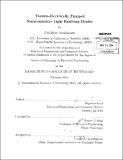| dc.contributor.advisor | Rajeev J. Ram. | en_US |
| dc.contributor.author | Santhanam, Parthiban | en_US |
| dc.contributor.other | Massachusetts Institute of Technology. Department of Electrical Engineering and Computer Science. | en_US |
| dc.date.accessioned | 2014-06-13T22:34:11Z | |
| dc.date.available | 2014-06-13T22:34:11Z | |
| dc.date.copyright | 2014 | en_US |
| dc.date.issued | 2014 | en_US |
| dc.identifier.uri | http://hdl.handle.net/1721.1/87935 | |
| dc.description | Thesis: Ph. D., Massachusetts Institute of Technology, Department of Electrical Engineering and Computer Science, 2014. | en_US |
| dc.description | Cataloged from PDF version of thesis. | en_US |
| dc.description | Includes bibliographical references (pages 217-227). | en_US |
| dc.description.abstract | Thermo-electric heat exchange in semiconductor light emitting diodes (LEDs) allows these devices to emit optical power in excess of the electrical power used to drive them, with the remaining power drawn from ambient heat. In the language of semiclassical electron transport, the electrons and holes within the device absorb lattice phonons as they diffuse from their respective contacts into the LED's active region. There they undergo bimolecular radiative recombination and release energy in the form of photons. In essence the LED is acting as a thermodynamic heat pump operating between the cold reservoir of the lattice and the hot reservoir of the outgoing photon field. In this thesis we report the first known experimental evidence of an LED behaving as a heat pump. Heat pumping behavior is observed in mid-infrared LEDs at sub-thermal forward bias voltages, where electrical-to-optical power conversion at arbitrarily high efficiency is possible in the limit of low optical output power. In this regime, the basic thermal physics of an LED differs from that seen at conventional higher voltage operating points. We construct a theoretical model for entropy transport in an LED heat pump and examine its consequences both theoretically and experimentally. We use these results to propose a new design for an LED capable of very high efficiency power conversion at power densities closer to the limit imposed by the Second Law of Thermodynamics. We then explore the potential application of these thermo-photonic heat pumps as extremely efficient sources for low-power communication and high-temperature absorption spectroscopy. | en_US |
| dc.description.statementofresponsibility | by Parthiban Santhanam. | en_US |
| dc.format.extent | 227 pages | en_US |
| dc.language.iso | eng | en_US |
| dc.publisher | Massachusetts Institute of Technology | en_US |
| dc.rights | M.I.T. theses are protected by copyright. They may be viewed from this source for any purpose, but reproduction or distribution in any format is prohibited without written permission. See provided URL for inquiries about permission. | en_US |
| dc.rights.uri | http://dspace.mit.edu/handle/1721.1/7582 | en_US |
| dc.subject | Electrical Engineering and Computer Science. | en_US |
| dc.title | Thermo-electrically pumped semiconductor light emitting diodes | en_US |
| dc.type | Thesis | en_US |
| dc.description.degree | Ph. D. | en_US |
| dc.contributor.department | Massachusetts Institute of Technology. Department of Electrical Engineering and Computer Science | |
| dc.identifier.oclc | 880144489 | en_US |
